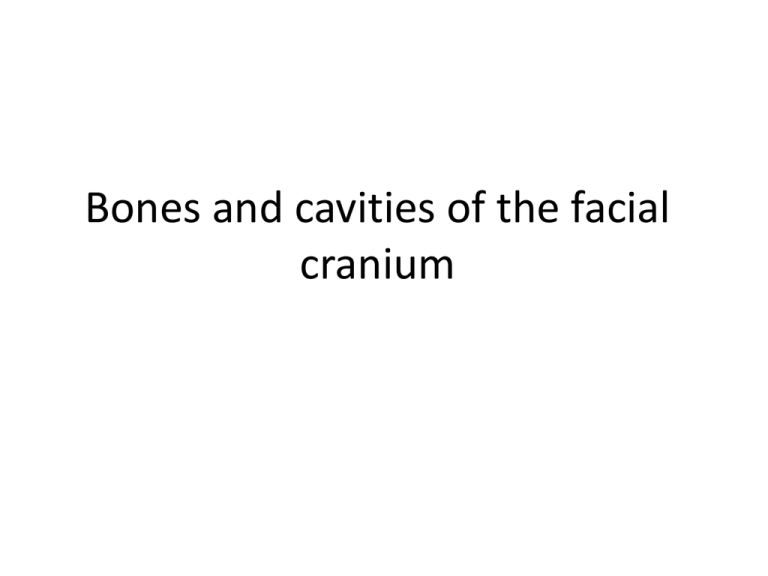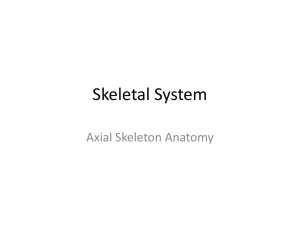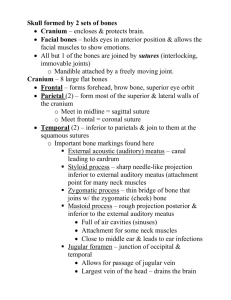Bones and cavities of the facial cranium
advertisement

Bones and cavities of the facial cranium TMJ Anterior Skull frontal bone supraorbit al foramenbone zygomatic mandibul ar symphysis mental foramen glabella infraorbita l foramen maxillar y bone alveolar fossa mandible Anterior Skull perpendicular plate superior orbital fissure inferior nasal concha bone nasal bone middle nasal concha vomer bone Paranasal Sinuses frontal sinus ethmoid sinus maxilary sinus sphenoid sinus coronal suture sagittal suture lambdoidal suture Cranium frontal bone parietal bon occipital bone palatine process palatine bone vomer bone temporal bone external occipital protuberance Ventral Skull sphenoid bone styloid process mastoid proces occipital bone carotid canal jugular foramen foramen magnum Occipital bone occipital condyle squamosal suture lacrimal bone temporal bone external acoustic meatus mandibular condyle In mandibular fossa Lateral Skull zygomatic arc sphenoid bone sutural bone mastoid process coronoi d process styloid process Lateral Skull ramus angle body mandible cribriborm plate crista galli lesser wing greater wing optic canal intenal acoustic meatus sella turcica ugular foramen Internal Skull Hyoid + external acoustic meatus Hyoid bone temmporal mandibular joint ________ ________ Sagittal Coronal Lambdoid Squamous Overview of Skull Geography • Facial bones form the anterior aspect • The cranial bones enclose the brain Vault • The cranial vault or calvaria forms the superior, lateral, and posterior aspects of skull • The cranial base forming the inferior aspect of skull Cranial Base • Cranial base forms the skull’s inferior aspect • Three prominent ridges divide the base into fossae • The brain rests on these cranial fossae completely enclosed by the cranial vault • The brain occupies the cranial cavity Cranium • The 8 cranial bones include; 2 parietal, 2 temporal frontal, occipital, sphenoid, ethmoid • Cranium is self- bracing allowing the bones to be thin, yet strong Occipital bone • Forms most of the posterior wall and base of skull • Articulates with parietal & temporal • Joins w/ sphenoid in the cranial floor • Forms internal walls of posterior cranial fossa Occipital bone - Int. landmarks • Hypoglossal canal, Posterior cranial fossa Temporal Bone • Forms the inferolateral aspects of the skull • Parts of the cranial floor • Divided into four regions; squamous tympanic, mastoid, and petrous-(int) Temporal Bone • The internal petrous region contributes to the cranial base • The petrous region and the sphenoid bone form the middle cranial fossa Temporal Bone - landmarks • Zygomatic process – Meets the zygomatic bone – Forms the cheek • Mandibular fossa – Receives condyle of mandible Temporal bones - landmarks • Stylomastoid foramen – exit for facial nerve • Carotid canal – entrance for the carotid artery which supplies blood to cerebral hemispheres Sphenoid bone • Bone spanning the width of middle cranial fossa • Articulates as central wedge of all cranial bones • Consists of central body and three processes; greater and lesser wings and pterygoid process (pos. view) Sphenoid - landmarks • • • • • Sella turcica (enclosure for pituitary gland) Optic foramina (passage of optic nerves) Superior orbital fissure (Nerves III, IV, V enter orbit) Foramen rotundum & ovale (Cranial Nerve V to face) Foramen spinosum (Middle meningeal artery) Ethmoid bone • Forms most of the area between the nasal cavity & orbits of eyes • Lies between nasal bones & sphenoid • Complex shape gives rise to nasal septum, sinuses and cribiform plate Ethmoid bone - landmarks • Cribiform plates – Forms roof of nasal cavity • Olfactory formina – Olfactory nerves enter brain • Crista galli – Attachment of the dura mater which secures brain in cavity Facial bones • Consists of 14 bones w/ only mandible and vomer unpaired • Others include maxillae, lacrimals, nasals, zygomatics, inferior nasal conchae, and palatines (not pictured) Mandible • Forms the lower jaw • Largest, strongest bone of the face • It has a body and two upwardly projecting sections called rami • Houses lower dentition Mandible - landmarks • • • • • • • • Mandibular angle Mandibular notch Coronoid process Mandibular condyle Alveolar margin Mandible formina Mental formina Ramus of mandible Maxillary bone • Forms upper jaw and central portion of facial skeleton • Fused medially • Articulates with all facial bones except mandible • Upper dentition • Forms 2/3 of hard palate of the mouth Zygomatic process Maxillary bone Maxillary bones - landmarks • Alveolar margin – Upper dentition • Frontal process – Forms lateral aspects of nose • Zygomatic process – Articulates with zygomatic bone • Maxillary sinuses – (Fig. 7.11) Palatine bones • The horizontal plates forms the posterior portion of hard palate • Vertical plate forms part of the posterolateral wall of nasal cavity and a small portion of orbit Palatine bones - landmarks • Horizontal plate – Posterior section of hard palate • Vertical plate – Part of the posteriolateral walls of nasal cavity • Orbital surface – Part of inferior medial aspect of orbit Vomer • Forms part of the nasal septum • Discussed with the nasal cavity Vomer - landmarks • Plow shape – Divides nasal septum into right and left parts Inferior Nasal Conchae - Landmark • The Inferior nasal conchae is just one of three in the nasal cavity • Superior and middle concha are on the Ethmoid bone The Orbits Paranasal sinuses • Note positioning around nasal cavity Paranasal sinuses • • • • Sphenoid sinus Frontal sinus Ethmoid sinus Maxillary sinuses Hyoid bone • Body – Neck muscle attachment • Greater horn – Neck muscle attachment • Lesser horn TMJ TMJ Capsule TMJ Capsule TMJ Motions TMJ Motions The Skull: Fractures • Egg Shell Fracture of the Parietal bones. • Results from a fall or blunt force to the head The Skull: Fractures • Another example of an egg shell fracture. Knife in Skull Above Orbit AP Projection






